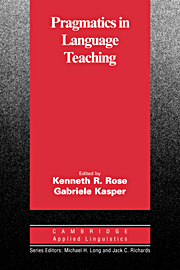Book contents
- Frontmatter
- Contents
- List of contributors
- Series editors' preface
- Preface
- Chapter 1 Pragmatics in language teaching
- I THEORETICAL AND EMPIRICAL BACKGROUND
- II ISSUES IN CLASSROOM-BASED LEARNING OF PRAGMATICS
- III THE EFFECTS OF INSTRUCTION IN PRAGMATICS
- IV THE ASSESSMENT OF PRAGMATIC ABILITY
- References
- Name index
- Subject index
IV - THE ASSESSMENT OF PRAGMATIC ABILITY
Published online by Cambridge University Press: 05 October 2012
- Frontmatter
- Contents
- List of contributors
- Series editors' preface
- Preface
- Chapter 1 Pragmatics in language teaching
- I THEORETICAL AND EMPIRICAL BACKGROUND
- II ISSUES IN CLASSROOM-BASED LEARNING OF PRAGMATICS
- III THE EFFECTS OF INSTRUCTION IN PRAGMATICS
- IV THE ASSESSMENT OF PRAGMATIC ABILITY
- References
- Name index
- Subject index
Summary
Despite the fact that communicative language teaching has now been with us for more than 3 decades, and a considerable amount of attention has been focused on developing ways to teach learners to use language for communication, far less effort has been expended in developing methods for assessing learners' ability to communicate in a second language. This has begun to change, particularly with work on the assessment of interlanguage pragmatics being carried out by established researchers in language testing.
One of the most frequently used formats for assessing oral proficiency is the oral proficiency interview or the simulated oral proficiency interview (SOPI). In the SOPI, candidates have to address a variety of communicative acts to interlocutors in different constellations of social relationships. Whether or not the SOPI elicits samples of candidates' performance that allow valid interpretations of their L2 sociolinguistic and pragmatic abilities is a central problem of construct validity. John Norris examines this issue in Chapter 12 by analyzing the use of address terms by American high school and university learners of German as a foreign language on the German Speaking Test (GST). For English-speaking learners of German, developing control over the address system involves the acquisition of complex interactions between sociopragmatic and pragmalinguistic aspects of the L2. Six tasks from the GST were identified (asking questions, giving directions, explaining a process, apologizing, requesting, and giving advice) which elicited substantial use of direct address forms and shared similar contextual constraints which likely encouraged the use of direct address.
- Type
- Chapter
- Information
- Pragmatics in Language Teaching , pp. 245 - 247Publisher: Cambridge University PressPrint publication year: 2001



